Class 6 Maths Chapter 5 Understanding Elementary Shapes
Exercise – 5.1
1. What is the disadvantage in comparing line segments by mere observation?
Solution: There may be chance of error due to improper viewing.
2. Why is it better to use a divider than a ruler, while measuring the length of a line segment?
Solution: It is better to use a divider than a ruler, because the thickness of the ruler may cause difficulties in reading of the length of a line segment. However, a divider gives accurate measurement.
3. Draw any line segment, say AB. Take any point C lying in between A and B. Measure the lengths of AB, BC and AC. Is AB=AC + CS? [Note : If A, B, C are any three points on a line such that AC + CB = AB, then we can be sure that C lies between A and B.]
Solution: AB = 4 cm, AC = 2 cm, CB = 2 cm
Hence, AC + CB = 2 cm + 2 cm = 4 cm = AB
Yes, AB = AC + CB.
Read and Learn More Class 6 Maths Exemplar Solutions
4. If A, B, C are three points on a line such that AB-5 cm, BC= 3 cm and AC=8 cm, which one of them lies between the other two?
Solution:
Given
A, B, C are three points on a line such that AB-5 cm, BC= 3 cm and AC=8 cm
Since, AC is the longest line segment.
Thus B is the point lying between A and C.
5. Verify, whether D is the mid point of AG.

Solution: AD= 3 units, DG = 3 units, AD = DG
Thus, D is Thw mid- point od AG.
6. If B is the mid point of AC and C is the mid point of BD, where A, B, C, D lie on a straight line, say why AB = CD?
Solution: B is the mid point of AC.
AB = BC …………..(1)
And C is the mid point of BD.
BC = CD ……………(2)
From (1) and (2), we get
AB = CD
7. Draw five triangles and measure their sides. Check in each case, if the sum of the lengths of any two sides is always less than the third side.
Solution: Sum of the lengths of any two sides of a triangle can never be less than length of the third side.

Exercise – 5.2
1. What fraction of a clockwise revolution does the hour hand of a clock turn through, when it goes from
(1) 3 to 9
(2) 4 to z7
(3) 7 to 10
(4) 12 to 9
(5) 1 to 10
(6) 6 to 3
Solution: (1)1/2 or two right angles
(2)1/4 or one right angle
(3)1/4 or one right angle
(4)3/4 or three right angles
(5)3/4 or three right angles
(6)3/4 or three right angles
2. Where will the hand of a clock stop if it
(1) starts at 12 and makes 1/2 of a revolution, clockwise?
(2) starts at 2 and makes 1/2 of a revolution, clockwise?
(3) starts at 5 and makes 1/4 of a revolution, clockwise?
(4) starts at 5 and makes 3/4 of a revolution, clockwise?
Solution: (1) At 6
(2) At 8
(3) At 8
(4) At 2
3. Which direction will you face if you start facing
(1) eastand make 1/2 ofa revolution clockwise?
(2) east and make 1×1/2 of a revolution clockwise?
(3) west and make 3/4 of a revolution anti clock wise?
(4)south and make one full revolution?
(Should we specify clockwise or anti-clockwise for this last question? Why not?)
Solution: (1) West
(2) West
(3) North
(4) South
No, it is not necessary to specify because whether we turn clockwise or anti-clockwise, one full revolution will bring us back to the
original position.
4. What part of a revolution have you turned through if you stand facing
(1) east and turn clockwise to face north?
(2) south and turn clockwise to face east?
(3) west and turn clockwise to face east7
Solution: (1) 3/4
(2) 3/4
(3) 1/2
5. Find the number of right angles turned through by the hour hand of a clock when it goes from
(1) 3 to 6
(2) 2 to 8
(3) 5 to 11
(4) 10 to 1
(5) 12 to 9
(6) 12 to 6
Solution: (1) One right angle
(2) Two right angles
(3) Two right angles
(4) One right angle
(5) Three right angles
(6) Two right angles
6. How many right angles do you make if you start facing
(1) south and turn clockwise to west?
(2) north and turn anti-clockwise to east?
(3) west and turn to west?
(4) south and turn to north?
Solution: (1) One right angle
(2) Three right angles
(3) Four right angles
(4) Two right angles
7. Where will the hour hand of a clock stop if it starts
(1) from 6 and turns through 1 right angle?
(2) from 8 and turns through 2 right angles?
(3) from 1 0 and turns through 3 right angles?
(4) from 7 and turns through 2 straight angles?
Solution: (1) At 9
(2) At 2
(3) At 7
(4) At 7
Exercise – 5.3
1. Match the following:
(i) Straight angle (1) Less than one-fourth of a revolution
(ii) Right angle (2) More than half a revolution
(iii) Acute angle (3) Half of a revolution
(iv) Obtuse angle (4) One-fourth of a revolution
(v) Reflex angle (5) Between 1/4 and 1/3 of a revolution
Solution: (i)—> (3); (ii)—> (4); (iii)—> (1);(iv)—>(5);(v)—>(2)
2. Classify each one of the following angles as right, straight, acute, obtuse or reflex :
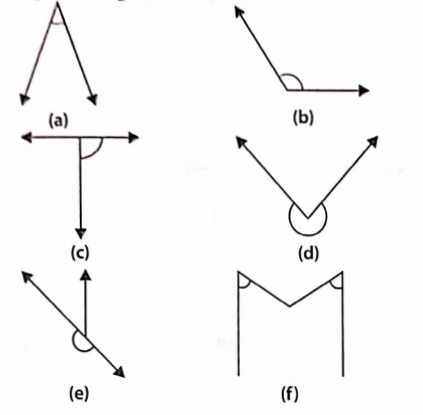
Solution: (a) Acute angle
(b) Obtuse angle
(c) Right angle
(d) Reflex angle
(e) Straight angle
(f) Acute angle
Exercise – 5.4
1. What is the measure of (i) a right angle? (ii) a straight angle?
Solution: (1) 90°
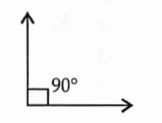
(2) 180°

2. Say True or False:
(1) The measure of an acute angle < 90°.
(2) The measure of an obtuse angle < 90°.
(3) The measure of a reflex angle > 1 80°.
(4) The measure of one complete revolution = 360°.
(5) If m∠A = 53° and m∠B = 35°, then m∠A > m∠B.
Solution: (1) True
(2) False
Since, measure of an obtuse angle is greater than 90° and less than 180°.
(3) True
(4) True
(5) True
3. Write down the measures of
(1) some acute angles.
(2) some obtuse angles. (give at least two examples of each).
Solution: (1) Measures of 2 acute angles are 35°, 20″
(2) Measures of 2 obtuse angles are 110°,135°
4. Measure the angles given below using the Protractor and write down the measure.
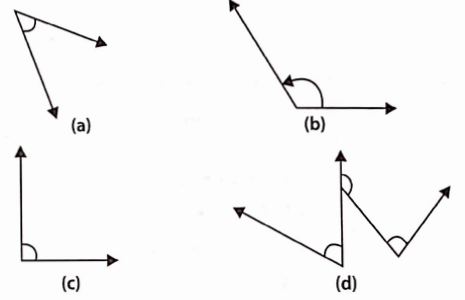
Solution: (a) Near about 40°
(b) Near about 130°
(c) Near about 90°
(d) Near about 60°, 120°, 90°
Note: Students can measure the angles exactly with the help of protractor.
5. Which angle has a large measure ? First estimate and then measure.
Measure of Angle A =
Measure of Angle B =
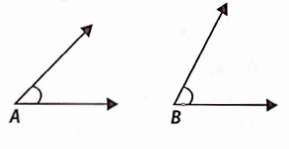
Solution: By estimating, we observe that ZB has a large measure.
∠A = near about 40° and ∠B = near about 65°.
Note: Students can measure the angles exactly with the help of protractor.
6. From these two angles which has larger measure? Estimate and then confirm by measuring them
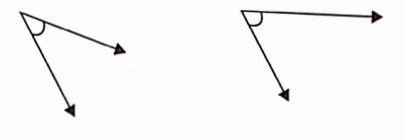
Solution: Second angle has larger measure.
First angle is near about .30″ and second angle is near about 70″.
Note: Students can measure the angles exactly with the help of protractor
7. Fill in the blanks with acute, obtuse, right or straight:
(1) An angle whose measure is less than that of a right angle is___________.
(2) An angle whose measure is greater than that of a right angle is____________.
(3) An angle whose measure is the sum of the measures of two right angles is__________.
(4) When the sum of the measures of two angles is that of a right angle, then each one of them is___________.
(5) When the sum of the measures of two angles is that of a straight angle and if one of them is acute then the other should be_____________.
Solution: (1) Acute
(2) Obtuse
(3) Straight
(4) Acute
(5) Obtuse
8. Find the measure of the angle shown in each figure. (First estimate with your eyes and then find the actual measure with a protractor).
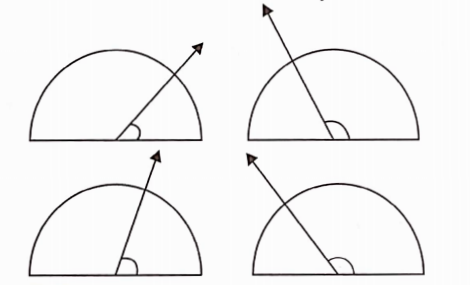
Solution: (1) By estimating with our eyes, we came to know that the measure of angle is 30°.
(2) By estimating with our eyes, we came to know that the measure of angle is 120°.
(3) By estimating with our eyes, we came to know that the measure of angle is 60°.
(4) By estimating with our eyes, we came to know that the measure of angle is 150°.
Note: Students can measure the angles exactly with the help of protractor.
9. Find the angle measure between the hands of the clock in each figure :

Solution: (1) 90° (Right angle)
(2) 30° (Acute angle)
(3) 180° (Straight angle)
10. Investigate In the given figure, the angle measures 30°. Look at the same figure through a magnifying glass. Does the angle becomes larger? Does the size of the angle change?

Solution: No, the measure of angle will be same.
11. Measure and classify each angle:
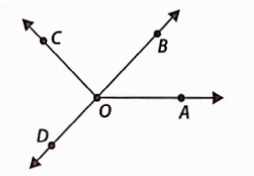
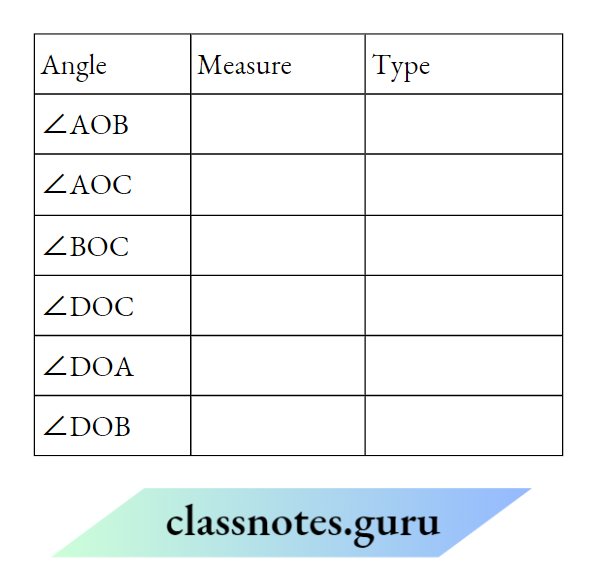
Solution:
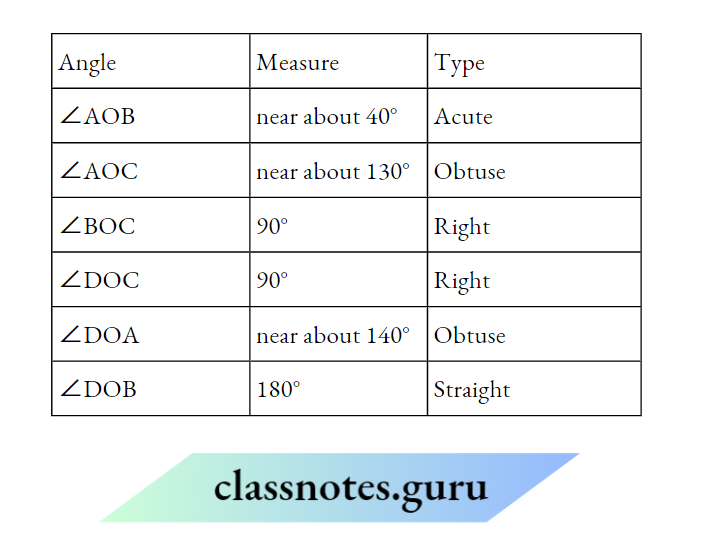
Note: Students can measure the angles exactly with the help of protractor.
Exercise 5.5
1. Which of the following arc models for perpendicular lines :
(1) The adjacent edges of a table top.
(2) The lines of a railway track.
(3) The line segments forming the letter ‘L’.
(4) The letter V.
Solution: (1) Perpendicular
(2) Not perpendicular
(3) Perpendicular
(4) Not perpendicular
2. Let PQ be the perpendicular to the line segment XY. Let PQ and XY intersect in the point A. What is the measure of ∠PAY1
Solution: ∠PAY = 90°
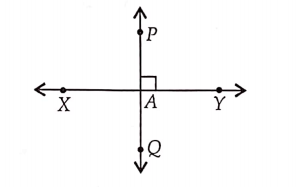
3. There are two set-squares in your box. What are the measures of the angles that are formed at their corners? Do they have any angle measure that is common?
Solution: One set-square has angles 45°, 90°, 45° and other set-square has angles 60°, 90°, 30°.
Yes, they have angle measure 90° as common.
4. Study the diagram. The line / is perpendicular to linem
(1) Is CE = EG?

(2) Does PE bisect CGI
(3) Identify any two line segments for which PE is the perpendicular bisector.
(4) Are these true?
(i) AC>FG
(ii) CD = GH
(iii) BC < EH.
Solution: (1) Yes, both measure 2 units.
(2) Yes, because CE = EG
(3) BH and DF are two line segments for which PE is the perpendicular bisector.
(4) (i) True
Since, AC = 2 units and FG =1 unit.
AC>FG
(ii) True
Since, CD = GH= 1 unit
(iii) True
Since, BC = 1 unit, EH = 3 units
BC < EH
Exercise – 5.6
1. Name the types of following triangles:
(1) Triangle with lengths of sides 7 cm, 8 cm and 9 cm.
(2) ΔABC with AB = 8.7 cm, AC = 7 cm and BC = 6 cm.
(3) ΔPQR such that PQ = QR = PR = 5 cm.
(4) ΔDEF with m∠D = 90°
(5) ΔXYZ with m∠Y = 90° and XY = YZ.
(6) ΔLMN with m∠L= 30°, m∠M = 70° and m∠N= 80°.
Solution: (1) Scalene triangle
(2) Scalene triangle
(3) Equilateral triangle
(4) Right-angled triangle
(5) Isosceles right-angled triangle
(6) Acute-angled triangle
2. Match the following :
Measures of Triangle Type of Triangle
(i) 3 sides of equal (1) Scalene length
(ii) 2 sides of equal length (2) Isosceles right
(iii) All sides are of different length (3) Obtuse angled
(iv) 3 acute angles (4) Right angled
(v) 1 right angle (5) Equilateral
(vi) 1 obtuse angle (6) Acute angled
(vii) 1 right angle with two sides of equal length (7) Isosceles
(i) -> (5); (ii) -» (7); (iii) -> (1); (iv) -> (6); (v) —> (4); (vi) —> (3); (vii) —> (2)
3. Name each of the following triangles in two different ways: (you may judge the nature of the angle by observation)
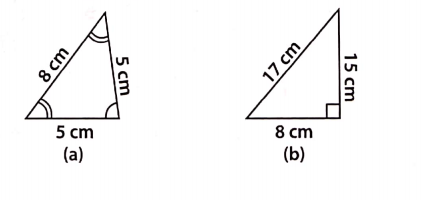
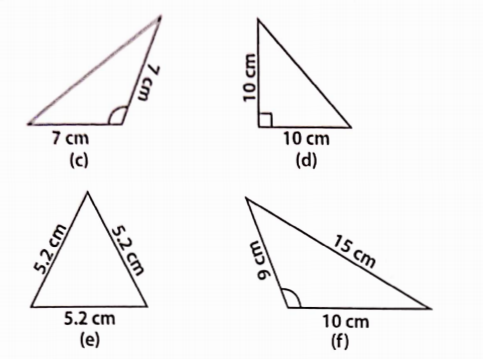
Solution: (a) Acute angled triangle and Isosceles triangle
(b) Right-angled triangle and Scalene triangle
(c) Obtuse-angled triangle and Isosceles triangle
(d) Right-angled triangle and Isosceles triangle
(e) Acute angled triangle and Equilateral triangle
(f) Obtuse-angled triangle and Scalene triangle
4. Try to construct triangles using match sticks. Some are shown here. Can you make a triangle with
(1) 3 matchsticks?
(2) 4 matchsticks?
(4) 6 matchsticks?
(3) 5 matchsticks?
(Remember you have to use all the available matchsticks in each case)
Name the type of triangle in each case. If you cannot make a triangle, think of reasons for it.

Solution: (1) Yes, it is possible to make a triangle with 3 matchsticks because sum of lengths of two sides is greater than the length of third side.
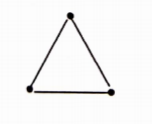
(2) No, it is not possible to make a triangle with 4 matchsticks because sum of lengths of two sides is equal to the length of third side.
(3) Yes, it is possible to make a triangle with 5 matchsticks because sum of lengths of two sides is greater than the length of third side.
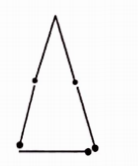
(4) Yes, it is possible to make a triangle with the help of 6 matchsticks because sum of lengths of two sides is greater than the length of third side.
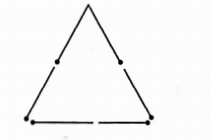
Exercise – 5.7
1. Say True or False:
(1) Each angle of a rectangle is a right angle.
(2) The opposite sides of a rectangle are equal in length.
(3) The diagonals of a square are perpendicular to one another.
(4) All the sides of a rhombus are of equal length.
(5) All the sides of a parallelogram are of equal length.
(6) The opposite sides of a trapezium are parallel.
Solution: (1) True
(2) True
(3) True
(4) True
(5) False
Since, opposite sides of a parallelogram are of equal length.
(6) False
Since, only one pair of opposite sides of a trapezium is parallel.
2. Give reasons for the following:
(1) A square can be thought of as a special rectangle.
(2) A rectangle can be thought of as a special parallelogram.
(3) A square can be thought of as a special rhombus.
(4) Squares, rectangles, parallelograms are all quadrilaterals.
(5) Square is also a parallelogram.
Solution: (1) Because its all angles are right angle and opposite sides are equal.
(2) Because its opposite sides are equal and parallel.
(3) Because its all sides are equal and diagonals are perpendicular to each other.
(4) Because all of them have four sides’.
(5) Because its opposite sides are equal and parallel.
3. A figure is said to be regular if its sides are equal in length and angles are equal in measure. Can you identify the regular quadrilateral?
Solution:
Given
A figure is said to be regular if its sides are equal in length and angles are equal in measure.
A square is a regular quadrilateral.
Exercise – 5.8
1. Examine whether the following are polygons. If any one among them is not, say why?
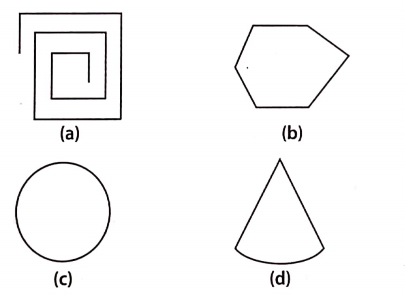
Solution: (1) As it is not a closed figure, therefore, it is not a polygon.
(2) It is a polygon because it is closed by line segments.
(3) It is not a polygon because it is not made by line segments.
(4) It is not a polygon because it is not made by only line segments and also it has curved surface.
2. Name each polygon.
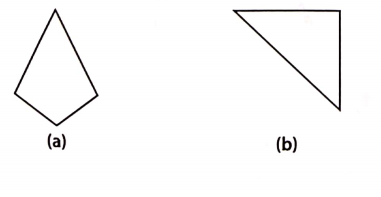
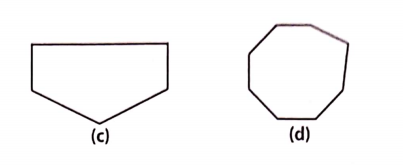
Make two more examples of each of these.
Solution:
(a) Quadrilateral
(b) Triangle
(c) Pentagon
(d) Octagon
Two more examples of each:
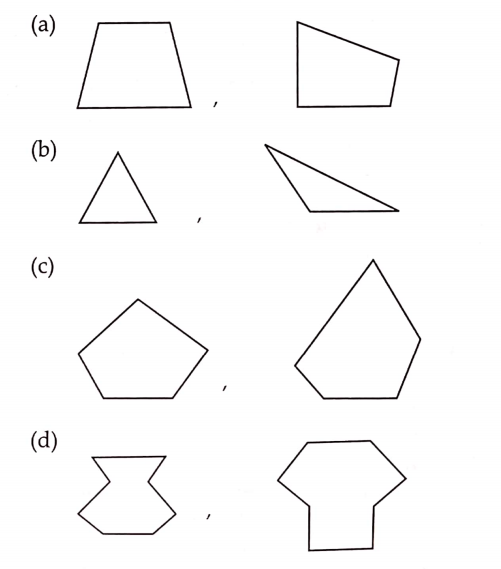
3. Draw a rough sketch of a regular hexagon. Connecting any three of its vertices, draw a triangle. Identify the type of the triangle you have drawn.
Solution:

ABCDEF is a regular hexagon and ΔAEF is a triangle formed by joining AE. Hence, ΔAEF is an isosceles triangle.
4. Draw a rough sketch of a regular octagon. (Use squared paper if you wish). Draw a rectangle by joining exactly four of the vertices of the octagon.
Solution:

ABCDEFGH is a regular octagon and CDGH is a rectangle formed by joining C and H; D and G.
5. A diagonal is a line segment that joins any two vertices of the polygon and is not a side of the polygon. Draw a rough sketch of a pentagon and draw its diagonals.
Solution:
Given
A diagonal is a line segment that joins any two vertices of the polygon and is not a side of the polygon
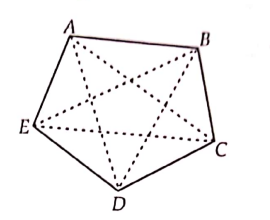
ABODE is the required pentagon and its diagonals are AD, AC, BE, BD and CE.
Section-2 NCERT Exemplar
Directions: In each of the questions1 to 11, out of four options only one is correct. Write the correct answer.
1. Measures of the two angles between hour and minute hands of a clock at 9 O’ clock are
(1) 60°, 300°
(2) 270°, 90°
(4) 30°, 330°
(3) 75°, 285°
Solution: (2): We know that 1 minute = 6°
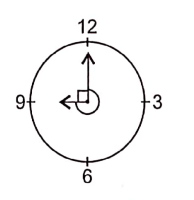
The number of minutes between hour and minute hands of a clock at 9 O’ clock is 15 and 45.
The required angles are 15 * 6° = 90° and 45×6° = 270°
2. If a bicycle wheel has 48 spokes, then the angle between a pair of two consecutive spokes is
\(\text { (A) }\left(5 \frac{1}{2}\right)\)\(\text { (B) }\left(7 \frac{1}{2}\right)\)
\(\text { (C) }\left(\frac{2}{11}\right)\)
\(\text { (D) }\left(\frac{2}{15}\right)\)
Solution: A bicycle wheel has 48 spokes.
The angle formed in circle is 360°.
The angle between a pair of two consecutive spokesr is 360 + 48 = \(7 \frac{24}{48}=7 \frac{1}{2}\)
3. In the given figure, ∠XYZ cannot be written as
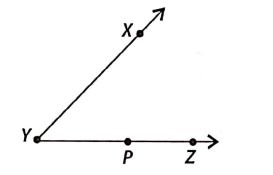
(1)∠Y
(2) ∠ZXY
(3) ∠ZYX
(4) ∠XYP
Solution: (2): In the given figure, the name of angles formed are ∠XYP, ∠XYZ, ∠PYX and ∠ZYX
Thus, ∠ZXY is not a correct option.
4. In the given figure, if point A is shifted to point B along the ray PX such that PB = 2PA, then the measure of ∠BPY is
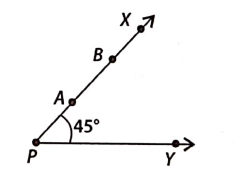
(1) greater than 45°
(2) Y45°
(3) less than 45°
(d) 90°
Solution: (2) : Since, the increase and decrease in the length of arms of an angle does not affect the angle made by them.
∠BPY = 45°
5. The number of obtuse angles In figure Is
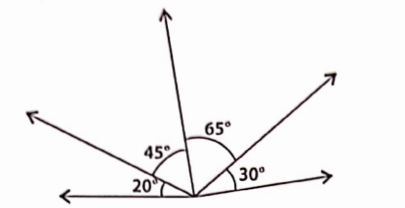
(1) 2
(2) 3
(3) 4
(4) 5
Solution: (3): The obtuse angles formed in the given figure are ∠AOD = 20° + 45° + 65° = 130°
∠BOD = 45° + 65° = 110°, ∠COE = 65° + 30° = 95° and ∠BOE = 45° + 65° + 30° = 140°
Thus, there are total 4 obtuse angles formed.
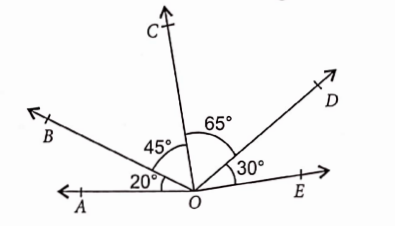
6. The number of triangles in the given figure is
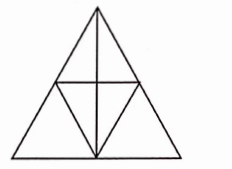
(1) 10
(2) 12
(4) 14
(3) 13
Solution: (3): We have,
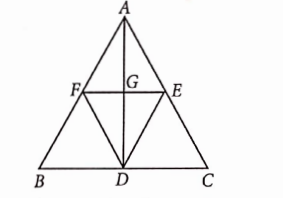
The names of triangles formed in the given figure are
ΔABC, ΔABD, ΔADC, ΔAFG, ΔAEG, ΔAFE, ΔFGD, ΔEGD, ΔFED, ΔFBD, ΔDEC, ΔAFD, ΔAED
7. If the sum of two angles is greater than 180°, then which of the following is not possible for the two angles?
(1) One obluso angle and one acute angle
(2) One reflex angle and one acute angle
(3) Two obtuse angles
(4) Two right angles
Solution: (4): Since, the sum of two rijÿht angles is 180°.
8. If the sum of two angles is equal to an obtuse angle, then which of the following is not possible?
(1) One obtuse angle and one acute angle
(2) One right angle and one acute angle
(3) Two acute angles
(4) Two right angles
Solution: (4): Since, the sum of two right angles is 180°, which is a straight angle, not an obtuse angle.
9. In the given figure, AB = BC and AD = BD = DC. The number of isosceles triangles in the figure is
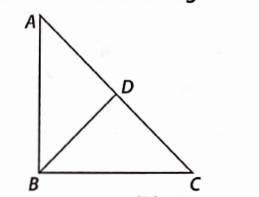
(1) 1
(2) 2
(3) 3
(4) 4
Solution: (3):
Given
In the given figure, AB = BC and AD = BD = DC.
We have, AB = BC and AD = BD = DC.
ΔABD, ΔBDC and ΔABC all are isosceles triangles.
There are 3 isosceles triangles formed in the given figure.
10. In the given figure, ∠BAC = 90° and AD ⊥ BC. The number of right triangles in the figure is

(1) 1
(2) 2
(3) 3
(4) 4
Solution: (3):
Given
In the given figure, ∠BAC = 90° and AD ⊥ BC.
We have, ∠BAC = 90° and AD ⊥ BC
∠BDA = ∠CDA = ∠BAC = 90°
There are 3 right triangles formed in the given figure.
11. In the given figure, PQ⊥ RQ, PQ = 5 cm and QR = 5 cm. Then ΔPQR is
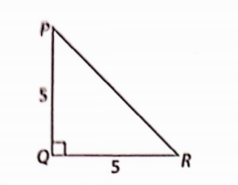
(1) a right triangle but not isosceles
(2) an isosceles right triangle
(3) isosceles but not a right triangle
(4) neither isosceles nor right triangle
Solution: (13) :
Given
In the given figure, PQ⊥ RQ, PQ = 5 cm and QR = 5 cm.
We have, PQ⊥ RQ, PQ = 5 cm and QR = 5 cm, which shows that in a triangle, two sides are equal and their included angle is 90°.
ΔPQR is an isosceles right triangle
Directions: In questions 12 to 17,fill in the blanks to make the statements true.
12. An angle greater than 180° and less than a complete angle is called________.
Solution: Reflex angle
13. A pair of opposite sides of a trapezium are
Solution: Parallel
14. In the given figure,

(1) ∠AOD is a/an __________ angle
(2) ∠COA is a/an__________ angle.
(3) ∠AOE is a/an__________ angle.
Solution: (1) Right : ∠AOD = 30° + 20° + 40° = 90°
(2) Acute : ∠COA = 20° + 30° = 50°
(3) Obtuse : ∠AOE = 40° + 40° + 20° + 30° = 130°
15. The number of triangles in figure is Their names are________.
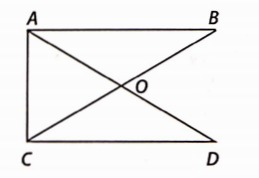
Solution: ΔAOB, ΔOC, ΔCOD, ΔCAB and ΔACD
16. Number of angles less than 180” in given figure is_______ and their names are_______.

Solution: 12, ∠ABO, ∠BAO, ∠AOB, ∠BOD, ∠COD, ∠ODC, ∠OCD, ∠OCA, ∠CAO, ∠AOC, ∠BAC and ∠ACD.
17. The number of right angles in a straight angle is__________ and that in a complete angle is___________
Solution: 2, 4 : The number of right angles in a straight angle is 2 and that in a complete angle is 4.
Directions: State whether the statements given in questions 18 to 20 are true (T) or false (F).
18. A horizontal line and a vertical line always intersect at right angles.
Solution: True
19. If the arms of an angle on the paper are increased, the angle increases.
Solution: False
If the arms of an angle on the paper are increasing or decreasing, it doesn’t affect the angle made by them.
20. If the arms of an angle on the paper are decreased, the angle decreases.
Solution: False
21. Write down fifteen angles (less than 180°) involved in given figure.
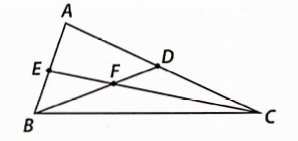
Solution: The names of fifteen angles (less than 180°) involved in figure are :
∠AEC, ∠ADB, ∠EAD, ∠EFD, ∠EFB, ∠DFC, ∠FBC, ∠FCB, ∠BFC, ∠ABC, ∠ACB, ∠DCF, ∠FDC, ∠EBF and ∠BEF.
22. Is it possible for the same
(1) line segment to have two different lengths?
(2) angle to have two different measures?
Solution: (1) No, it is not possible for the same line segment to have two different lengths.
(2) No, it is not possible for the same angle to have two different measures.
23. Will the measure of ∠ABC and of ∠CBD make measure of ∠ABD in given figure?

Solution: Yes, ∠ABD- ∠ABC + ∠CBD
=> ∠ABD is the sum of ∠ABC and ∠CBD.
24. Will the lengths of line segment AB and line segment BC make the length of line segment AC in given figure?
![]()
Solution: Yes, the length of line segment AC is the sum of the lengths of line segment AB and BC.
25. Look at a given figure. Mark a point
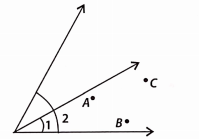
(1) A which is in the interior of both∠1 and ∠2.
(2) B which is in the interior of only ∠1.
(3) Point C in the interior of ∠1.
Now, state whether points B and C lie in the interior of ∠2 also.
Solution: Yes, the given figure shows that the points B and C lie in the interior of ∠2 also.
26. In which of the following figures,
(1) perpendicular bisector is shown?
(2) bisector Is shown?
(3) only bisector is shown?
(4) only perpendicular is shown?

Solution:
(1) Figure (ii) shows the perpendicular bisector.
(2) Figure (ii) and (iii) shows the bisector.
(3) Figure (iii) shows only the bisector.
(4) Figure (i) shows only the perpendicular.
27. In given figure,
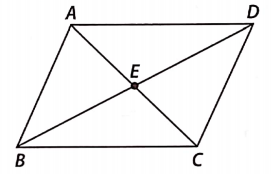
(1) name any four angles that appear to be acute angles.
(2) name any two angles that appear to be obtuse angles.
Solution: (1) Acute angles: ∠ADE, ∠AEB,∠ABE and ∠ECD.
(2) Obtuse angles: ∠BCD and ∠BAD.
28. In given figure,
![]()
(1) is AC + CB = AB?
(2) is AB + AC =CB?
(3) is AB + BC = CA?
Solution: (1) Yes, AC + CB = AB
(2) No, AB- AC = CB
(3) No, AB-BC = CA
29. In given figure,

(1) What is AE + EC?
(2) What is AC-EC?
(3) What is BD-BE?
(4) What is BD-DE?
Solution: (1) AE+EC=AC
(2) AC-EC=AE
(3) BD-BE = ED
(4) BD- DE = BE
30. Using the information given, name the right angles in each part of given figures.
(1) BA⊥BD

(2) RT⊥ST

(3) AC⊥BD
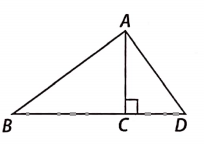
(4) RS⊥RW
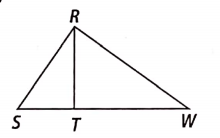
(5) AC⊥BD
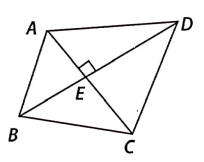
(6) AE⊥CE
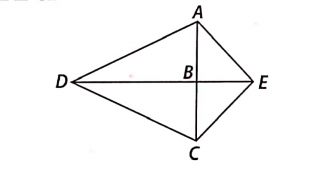
(7) AC⊥CD

(8) OP⊥AB
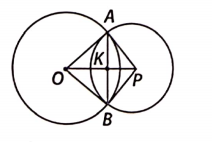
Solution: (1) BA ⊥ BD, The right angle is ∠ABD.
(2) RT ⊥ ST, The right angle is ∠RTS
(3) AC⊥BD, The right angles are ∠ACD and ∠ACB.
(4) RS⊥RW, The right angle is ∠SRW.
(5) AC ⊥ BD, The right angles are ∠AED, ∠AEB,∠BEC and ∠CED.
(6) AE ⊥CE, The right angle is ∠AEC.
(7) AC ⊥ CD, The right angle is ∠ACD.
(8) OP⊥AB, The right angles are ∠AKO, ∠AKP, ∠BKO and ∠BKP.
31. What conclusion can be drawn from each part of given figures, if
(1) DB is the bisector of ∠ADC?
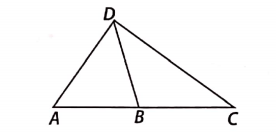
(2) BD bisects ∠ABC?

(3) DC is the bisector of ∠ADB, CA ⊥ DA and CB ⊥ DB?
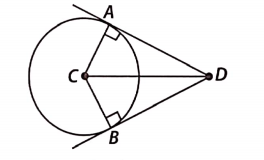
Solution: (1) DB is the bisector of ∠ADC.
∠ADB =∠CDB
(2) BD bisects ∠ABC.
∠ABD = ∠CBD
(3) DC is the bisector of ∠ADB, CA ⊥ DA and CB ⊥ DB
∠ADC = ∠BDC, ∠CAD = ∠CBD =90°
32. An angle is said to be trisected, if it is divided into three equal parts. If in a given figure, ∠BAC = ∠CAD = ∠DAE, how many trisectors are there for ∠BAE?
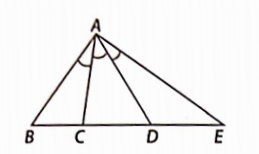
Solution:
Given
An angle is said to be trisected, if it is divided into three equal parts. If in a given figure, ∠BAC = ∠CAD = ∠DAE,
We have given, ∠BAC = ∠CAD = ∠DAE
There are two trisectors namely, AC and AD.
33. Can we have two acute angles whose sum is
(1) an acute angle? Why or why not?
(2) a right angle? Why or why not?
(3) an obtuse angle? Why or why not?
(4) a straight angle? Why or why not?
(5) a reflex angle? Why or why not?
Solution: (1) Yes, v the sum of two acute angles can be the acute angle.
E.g., 30° and 40° are two acute angles and their sum = 30° + 40° = 70°, which is also an acute angle.
(2) Yes, v the sum of two acute angles be a right angle.
E.g., 30° and 60° are two acute angles and their sum = 30° + 60° = 90°, which is a right angle.
(3) Yes, the sum of two acute angles can be an obtuse angle.
E.g., 45° and 60° are two acute angles and their sum = 45° + 60° = 105°, which is an obtuse angle.
(4) No, v the sum of two acute angles is always less than 180°.
(5) No, v the sum of two acute angles is always less than 180°.
34. Can we have two obtuse angles whose sum is
(1) a reflex angle? Why or why not?
(2) a complete angle? Why or why not?
Solution: (1) Yes, v the sum of two obtuse angles is always greater than 180°.
E.g., 135° and 100° are two obtuse angles and their sum = 135° + 100° – 235°, which is greater than 180°.
(2) No, v the sum of two obtuse angles is greater than 180° but less than 360°. In the above example, we can see that the sum of 135° and 100° i.e., 235° is greater than 180° but less than 360°.
